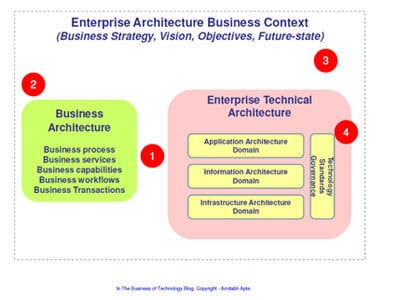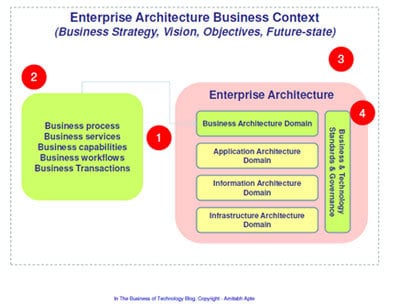I think that the business architecture is one of the key enablers of the enterprise architecture and makes it real. While the enterprise architecture offers much needed context for the business architecture.
It might be useful to briefly review the definitions of both business architecture and enterprise architecture before understanding issues in their relationship.
Enterprise architecture should not be limited to the IT or technology concerns of an organisation. Rather it should be focused on addressing much broader scope covering the business, functional, operational, financial and people aspects of the enterprise.
There are a number of enterprise architecture definitions out there. A couple of my favourite ones are as follows:
Enterprise architecture provides a strategic planning framework that relates and aligns information technology with the business functions that it supports.
Or
Practice of enterprise architecture involves developing a framework to describe a series of "current", "intermediate" and "target" reference architectures and applying them to align change within the enterprise. Another set of terms for these are "as-is", "to-be" and the "migration plan".
The Business Architecture Special Interest Group of Object Management Group (OMG) defines business architecture as follows: “A Blueprint of the Enterprise That Provides A Common Understanding Of The Organisation And Is Used To Align Strategic Objectives And Tactical Demands.”
TOGAF defines Business Architecture as: “Business Architecture describes the product and/or service strategy, and the organisational, functional, process, information, and geographic aspects of the business environment”
I think that though the practice of both business architecture and enterprise architecture has matured over the past few years, there certainly are some issues when it comes to these two working well together. I have summarised them in four broad arguments;
- Business architecture not done at all. Enterprise architecture teams only perform enterprise technical architecture only.
- Business architecture done in isolation of enterprise technical architecture and then (if lucky) artificially superimposed
- Business architecture and business context confusion: confusion between why, what and how
- Technology focused governance: only conversations about technical standards, business governance disconnected from IT investment and decisions leading to critical gaps
I have tried to capture this pictorially below:

This issue is getting wider acknowledgement given its strategic importance. I particularly like Randy Heffner’s work in this space. He states in one of his blogs;
‘Simply positioning business architecture as a layer on top of existing EA domains is a mistake. Traditionally many organisations have pursued EA as Enterprise Technical Architecture (ETA). ETA is technology-centred. Business architecture is business-centred. Simply layering it on top of ETA will result in tech-centred silo implementation.’
As Business Architecture Special Interest Group of Object Management Group (OMG) states, the business architecture defines the structure of the enterprise in terms of its governance structure, business processes, and business information. In defining the structure of the enterprise, business architecture considers customers, finances, and the market to align strategic goals and objectives with decisions regarding products and services; partners and suppliers; organisation; capabilities; and key initiatives.
Business Architecture primarily should focus on the business motivations, business operations and business analysis frameworks and related networks that link these aspects of the enterprise together and it should be seamlessly integrated with enterprise architecture efforts within the organisation.
In my experience to tackle above listed issues, following measures can be taken by the architecture team;
- Business architecture as part of enterprise architecture
- Business architecture drives enterprise architecture domains
- Business architecture and business context clarified and integrate
- Business-aligned technology governance
My pictorial representation from earlier changes as below now:

Modern enterprise architecture teams and enterprise architects can not longer afford to ignore the implications of business architecture. Likewise, modern business architects can no longer afford to work in isolation of organisation’s enterprise architecture. In conclusion of this article I would like to summarise my thoughts as follows:
- Enterprise architecture in isolation of business architecture is simply enterprise technical architecture
- Business architecture should guide the development of enterprise architecture domains
- Business architecture combined with enterprise architecture is a powerful tool for business-IT alignment
- Strategic frameworks and models help in achieving this alignment
And as Chris Potts would argue, the chief executive of an organisation should be ultimately accountable for ensuring the two come together as we would expect him or her to be the Chief Enterprise Architect of the Enterprise!












